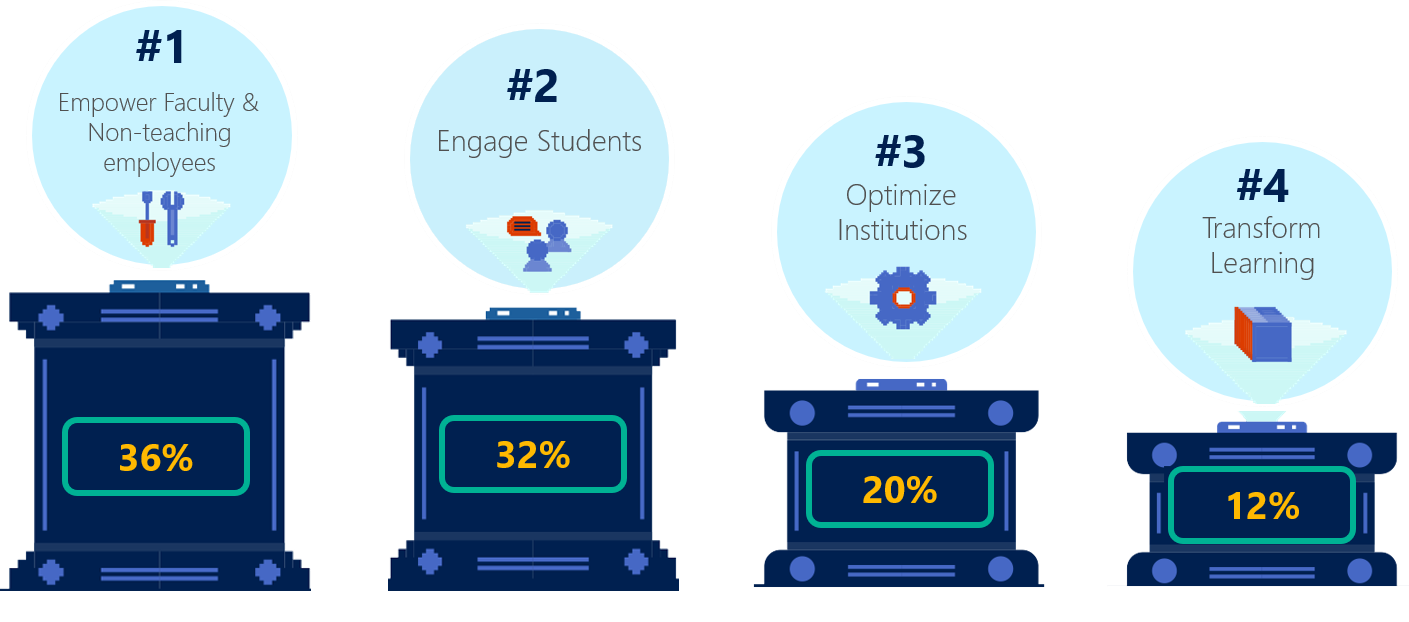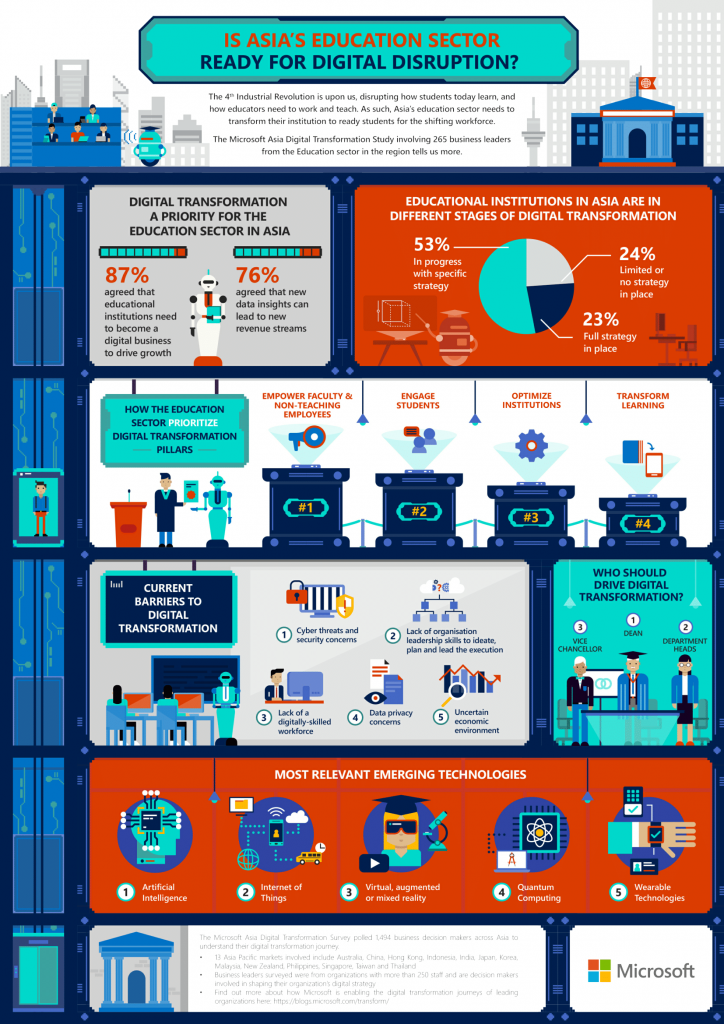Leaders in Asia Pacific’s education sector are showing urgency in embracing the 4th Industrial Revolution. 87% of them believe that they need to transform to a digital institution to enable future growth, yet only 23% said that they have a full digital strategy in place today. These are some of the key findings of the Microsoft Asia Digital Transformation Survey,[1] which seeks to understand how education leaders are embracing the digital era to prepare a future ready workforce.
The Microsoft Asia Digital Transformation Study surveyed 1,494 business leaders from Asia Pacific working in organizations with more than 250 employees from 13 Asia Pacific markets. This included 265 respondents from higher education institutions and universities. All respondents were pre-qualified as being involved in shaping their institution’s digital strategy.
Even as majority of education leaders are aware of the urgent need to transform digitally to address the changing landscape, the study found that the transformation journey for most educational institutions in Asia is still at its infancy. In fact, only 77% of education leaders indicated that they are either in progress with specific digital transformation initiatives, or have limited or no strategy in place.
Don Carlson, Director, Education, Microsoft Asia Pacific said: “Digital disruption has resulted in a shift in how work is being approached and conducted, and it is important that education institutions transform in order to equip students with future-ready skills, such as honing their creativity and critical thinking capabilities. At Microsoft, we have a specific and nuanced approach to digital transformation in education. We believe this involves transformation in four key pillars – empowering faculty and non-teaching employees, engaging students, optimizing institutions and transforming learning, with data and the cloud being the key enablers.”
Clear Priorities for Digital Transformation but True Transformation Lacking
Microsoft has defined what it means to transform in four key pillars:
- Engage students: Students and parents are demanding more from education, and the more students are engaged, the more they learn. Education institutions need to adopt digital, interactive, and personalized content to engage students. Concurrently, they must prepare students with skills to succeed in the future, especially as computational thinking and creativity skillsets are highly sought after.
- Empower faculty and non-teaching employees: The nature of how we work—and the workplace itself—has undergone a dramatic evolution. With the right technology, educators can access the best tools to engage students in and out of the classroom, and non-teaching employees can meet compliance requirements to deliver exceptional student experiences.
- Optimize institutions: With vast stores of data generated across the departments or faculties, educational institutions can gain breakthrough insights into student performance and institutional efficiency with analytics. Real-time intelligence also allows them to meet transparency expectations and regulatory requirements.
- Transform learning: As education becomes modernized and school leaders look to transform learning, access to technology tools will allow educators to drive new research with agile, highly-automated digital processes. Connecting devices, applications and online services with security at top-of-mind will also help connect the segment and its leadership to transform learning.
The Study shows how leaders in the education sector are prioritizing their digital transformation strategies:

Said Carlson: “Student insights are the new currency for education institutions, and 76% of education leaders agreed that new data insights would lead to new curriculums and learning outcomes. There is a need to rethink how leaders can better capitalize the value of latent data and embrace a different way of bringing together people, data and processes for their digital transformation success.”
Emerging Technologies in Demand
In the next 12 to 18 months, education leaders in Asia Pacific are interested to explore a range of emerging technologies to accelerate and achieve digital transformation. The top technologies identified by education leaders as being relevant to them are:
- Artificial intelligence: Intelligent machines or software that are able to learn and perform tasks independently. Examples include robots and chatbots;
- Internet of Things (IoT): Network of sensors embedded into devices that can collect data or be remotely controlled. Examples include smart buildings and home devices;
- Mixed reality: Technologies enabling the merging of real and virtual worlds into new and immersive experiences. Examples include Microsoft HoloLens, Oculus Rift, and 3D video gaming;
- Quantum computing: Next-generation computers using different computation systems to solve data equations much faster than traditional computers;
- Wearable technologies: Advanced computing and electronic technologies that are embedded into clothing, devices or bodies. Examples include smart watches and fitness trackers.
Barriers to Digital Transformation in Asia Pacific
While there is no doubt that digital transformation will bring significant benefits for both businesses and employees, the path to digital transformation has been slow, given that only 23% have a full digital strategy in place. According to education leaders in the study, the top barriers to digital transformation faced by Asia’s education industry are, in order of priority:

Increasing security threats in today’s digital economies is real and cannot be ignored. There is a continued perception among business leaders that the cloud is less secure. However, they may be less privy to the advances being made in the cloud on security and privacy and need more exposure on how, with the current threat environment, it will be safer being in the cloud than relying on tradition forms of IT.
“People don’t use technology that they don’t trust. This is a golden rule that applies to organizations and individuals alike. Ensuring security, privacy, and compliance are key to enabling educational institutions to carry out digital transformation with confidence. As such, protecting sensitive data requires a new and integrated approach, all of which we have invested in significantly,” said Carlson.

More information on Microsoft in Education, can be found at: https://www.microsoft.com/en-us/education
[1] The Microsoft Asia Digital Transformation Study was conducted between October to November 2016 involving 1,494 business leaders in 13 Asia Pacific markets. The 13 markets include Australia, China, Hong Kong, Indonesia, India, Japan, Korea, Malaysia, New Zealand, the Philippines, Singapore, Taiwan and Thailand. All respondents were pre-qualified as being involved in shaping their organisations’ digital strategy, and are working in firms with more than 250 employees.





